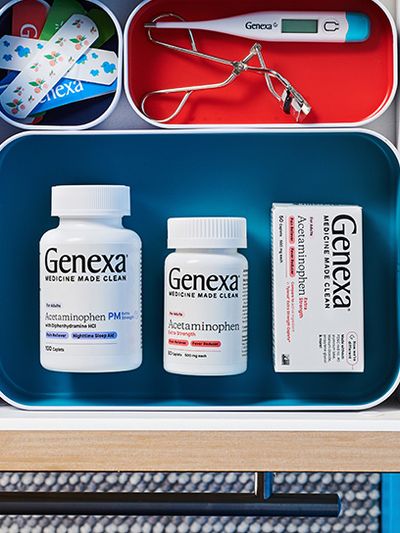What Is A Low FODMAP Diet?
What Does FODMAP Mean, Anyway?
Written by Dr. Nelli Gluzman - Genexa Healthcare Provider & Partner on August 25, 2021
Medically reviewed by Camille Freking, MS Pharmacology
If you are struggling with digestive issues and are looking for a diet that is right for you, it might be helpful to try a low FODMAP diet. This article will provide you with an overview of the low FODMAP diet, tips for how to implement it, and factors to consider to determine whether it is right for you.
What is a FODMAP and a Low FODMAP Diet?
The acronym FODMAP stands for fermentable, oligo-, di-, mono- saccharides, and polyols. Oligosaccharides, disaccharides, and monosaccharides are all carbohydrates that can trigger digestive problems in sensitive people. These problems can include but are not limited to symptoms such as gas, stomach pain, and bloating, especially after meals.
FODMAPs are found in several of the foods that make up a typical Western diet. They are especially prevalent in the following foods:
- Oligosaccharides: Vegetables like garlic and onions, fruits, legumes, wheat, and rye
- Disaccharides: Foods with lactose such as milk, yogurt, and soft cheese
- Monosaccharides: Foods with fructose, such as fruits like mangoes and figs and sweeteners like honey and agave nectar
- Polyols: Low-calorie sweeteners, fruits such as blackberries and lychee, and vegetables
Essentially, FODMAP is the name for a group of fermentable carbs that can cause digestive upset, bloating, and flatulence in certain people. As you might have guessed, a low FODMAP diet is one where the amount of FODMAPs that you eat is highly restricted.
Would I Benefit From A Low FODMAP Diet?
The people who would benefit most from a low FODMAP diet are those that cannot easily process FODMAPs. Usually, a low FODMAP diet is suggested for people with irritable bowel syndrome, or IBS.
Irritable Bowel Syndrome
The symptoms of IBS can include stomach pain, bloating, bowel urgency, flatulence, and reflux. The two most common symptoms are stomach pain and bloating. Although most people experience these symptoms from time to time, IBS is characterized by debilitating pain that can interfere with day-to-day activities.
Although there is no test for IBS, there are three criteria that you must meet to be diagnosed with this syndrome.
The criteria for IBS diagnosis include:
- Recurrent stomach pain that happens at least once a week and lasts for at least three months
- Stool that often changes in appearance, consistency, frequency, and texture
- Symptoms that do not stop for at least three months and initially started at least six months before diagnosis
Irritable Bowel Syndrome and a Low FODMAP Diet
A low FODMAP diet has been shown to greatly reduce the pain and discomfort associated with IBS. A low FODMAP diet may help reduce stomach pain and bloating, as well as flatulence, diarrhea, and constipation in those with IBS.
If you have IBS, a low FODMAP diet might be beneficial to you if you have ongoing digestive problems, difficulty managing stress, and problems with initial dietary suggestions for people with IBS. Treatment recommendations for IBS often include eliminating alcohol, caffeine, spicy foods, and other triggering foods from your diet.
Can a Low FODMAP Diet Be Harmful?
Yes, a low FODMAP diet can potentially be harmful to people who do not suffer from IBS and have a healthy gut because most FODMAPs are prebiotics. Prebiotic foods contain dietary fiber that most people need to incorporate into their diet to feed the healthy bacteria that live in their gut. Dietary fiber moves undigested through your system to your gut where it becomes fuel for beneficial bacteria.
Without prebiotics, healthy and probiotic bacteria cannot flourish. For this reason, going on a low FODMAP diet if you do not have IBS or if it has not been suggested by a doctor may end up being harmful to your overall health.
How To Implement a Low FODMAP Diet
Implementing a low FODMAP diet is a serious commitment that requires several large dietary changes for most people.
For this reason, it is important to think about transitioning to a low FODMAP diet during a time of relatively low stress where you are not incredibly busy or traveling frequently. The three stages involved in implementing a low FODMAP diet are outlined below.
Restriction
Arguably the hardest part of implementing a low FODMAP diet is the restriction stage. During this stage, you have to avoid all foods that are high in FODMAPs.
Even if this brings an incredible amount of relief, this stage of the diet should only last for 3-8 weeks because, as previously mentioned, FODMAPs are generally good for the gut and necessary for maintaining a healthy gut microbiome.
Reintroduction
The second stage of a low FODMAP diet involves slowly reintroducing high-FODMAP foods back into your diet. The purpose of this stage is to gain more specific information about your food tolerances and intolerances.
It is rare for people to be sensitive to all high-FODMAP foods, so it is important to know which specific ones your body can process.
This stage will also allow you to establish how many FODMAPs you can tolerate at a given time. This information is known as your “threshold level” and will be very important moving forward.
During this stage, you will introduce one high-FODMAP food back into your diet for 1-3 days per food type. Given that there are so many high-FODMAP foods, it can be helpful to consult a dietician to make sure you are executing this stage properly.
Although it may be tempting to incorporate several high-FODMAP foods back into your diet at once, it is important to remember to continue a low FODMAP diet during this time. Even if you have success with one high-FODMAP food, you should wait to reintroduce it fully until the third stage of the diet so that you can continue to gauge your reaction to specific foods.
Remember that even though this stage can be very uncomfortable while you are testing foods that you are intolerant to, digestive symptoms do not cause any serious damage to your body. It is also helpful to remember that people with IBS can tolerate small amounts of IBS, unlike people with serious food allergies.
Personalization
The personalization stage of a low FODMAP diet involves incorporating what you learned during stage two of the process to build a diet that is suited to your personal preferences.
Although you will likely introduce some high-FODMAP foods back into your diet, you will still be eating a modified version of a low FODMAP diet. The benefit of stage two is that it will allow you to incorporate all high-FODMAP foods possible for optimal gut health.
Even if it feels strange to incorporate high-FODMAP foods back into your diet, it is important to do so for your gut and overall health. It is also important to make your diet as flexible and varied as possible. Generally, a diet that contains a wide, balanced variety of foods is the healthiest.
Tips For Success With A Low FODMAP Diet
A low FODMAP diet can sound intimidating and for good reason. Luckily, there are a few tips to keep in mind before trying one that will help you succeed.
Talk To Your Doctor About IBS
Given that a low FODMAP diet is a commitment and can involve a large amount of dietary change, it is important to talk to your doctor about IBS before starting this diet to ensure you’ll get the most benefit.
There are several different physical and psychological triggers that can lead to digestive issues, so talking with your doctor can help you confirm if you have IBS. Although there is no test for IBS, your doctor can help you decide if your digestive problems are a result of IBS or another digestive disorder, such as celiac disease.
Make Simple Dietary Changes
Before you decide to invest your time, energy, and money in a low FODMAP diet, there are a few simple dietary changes you can make that may help relieve your IBS symptoms. As previously mentioned, you can try restricting caffeine, alcohol, spicy foods, and any foods that trigger you specifically.
Prepare Ahead of Time
If you are planning to make a large dietary change and implement a low FODMAP diet, it is important to prepare your pantry. Get rid of or donate all of the high-FODMAP foods in your fridge and pantry so that the temptation to eat them is not there.
It can also be helpful to prepare before going to a grocery store or restaurant. Consider making a grocery list so that you do not have to research what you can and cannot eat in the store. It might also be beneficial to look at a restaurant’s menu before going to see what you can eat.
Conclusion
A low FODMAP diet is one that is low in foods that contain specific carbohydrates. This diet is recommended for people with IBS and can be incredibly beneficial in improving the overall quality of life for people with digestive issues.





